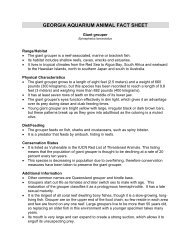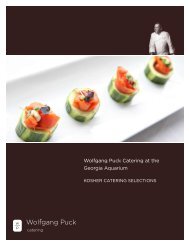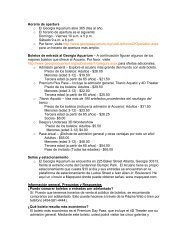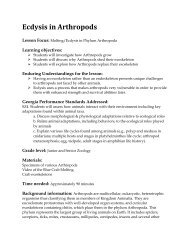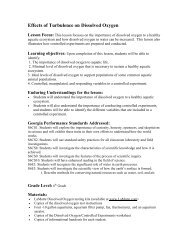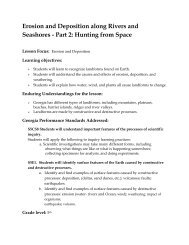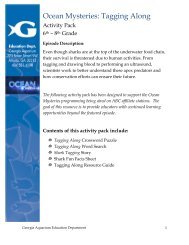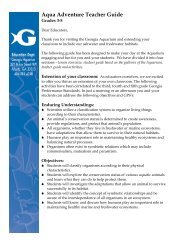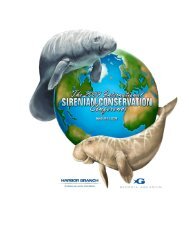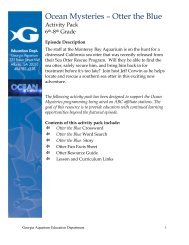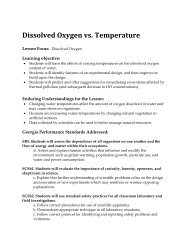Bite-Size Basics - Georgia Aquarium
Bite-Size Basics - Georgia Aquarium
Bite-Size Basics - Georgia Aquarium
Create successful ePaper yourself
Turn your PDF publications into a flip-book with our unique Google optimized e-Paper software.
<strong>Bite</strong>-<strong>Size</strong> <strong>Basics</strong> <br />
Teachers Guide<br />
Kindergarten-2 nd Grade<br />
Program Description: All animals have certain basic needs, including<br />
food! Come discover how some of the aquarium’s residents meet this need<br />
and learn about the different things aquatic animals eat and how they get their<br />
food.<br />
Enduring Understandings for <strong>Bite</strong>–<strong>Size</strong> <strong>Basics</strong>:<br />
All organisms have basic needs for survival<br />
Aquatic animals eat many different types of food in many different ways<br />
Through observations we can learn about aquatic animals and their<br />
habitats<br />
Objectives:<br />
Students will understand the basic needs of animals: shelter, water, air, and<br />
food<br />
Students will identify similarities and differences in the ways that animals<br />
eat<br />
Students will discover how they can learn about an animal by observing it<br />
<strong>Georgia</strong> Performance Standards Addressed:<br />
Kindergarten<br />
SKCS1. Students will be aware of the importance of curiosity, honesty,<br />
openness, and skepticism in science and will exhibit these traits in their own<br />
efforts to understand how the world works.<br />
a. Raise questions about the world around you and be willing to seek answers<br />
to some of the questions by making careful observations (5 senses) and trying<br />
things out.<br />
SKCS5. Students will communicate scientific ideas and activities clearly.<br />
a. Describe and compare things in terms of number, shape, texture, size,<br />
weight, color, and motion.<br />
SKL1. Students will sort living organisms and non-living materials into groups<br />
by observable physical attributes.<br />
b. Group animals according to their observable features such as<br />
appearance, size, motion, where it lives, etc. (Example: A green frog has<br />
four legs and hops. A rabbit also hops.)<br />
The <strong>Georgia</strong> <strong>Aquarium</strong> – Education Department 1
SKL2. Students will compare the similarities and differences in groups of organisms.<br />
a. Explain the similarities and differences in animals. (color, size, appearance,<br />
etc.)<br />
ELAKLSV1 The student uses oral and visual skills to communicate. The student<br />
a. Listens and speaks appropriately with peers and adults.<br />
b. Follows two-part oral directions.<br />
e. Describes people, places, things, locations, and actions.<br />
f. Increases vocabulary to reflect a growing range of interests and knowledge.<br />
First Grade<br />
S1CS1. Students will be aware of the importance of curiosity, honesty, openness, and<br />
skepticism in science and will exhibit these traits in their own efforts to understand how<br />
the world works.<br />
a. Raise questions about the world around them and be willing to seek answers<br />
to some of the questions by making careful observations and measurements and<br />
trying to figure things out.<br />
S1CS5. Students will communicate scientific ideas and activities clearly.<br />
a. Describe and compare things in terms of number, shape, texture, size, weight,<br />
color, and motion.<br />
S1L1. Students will investigate the characteristics and basic needs of plants and animals.<br />
b. Identify the basic needs of an animal. ( air, water, food, shelter)<br />
d. Compare and describe various animals—appearance, motion, growth, basic<br />
needs.<br />
ELA1LSV1 The student uses oral and visual strategies to communicate. The student<br />
a. Follows three-part oral directions.<br />
b. Recalls information presented orally.<br />
c. Responds appropriately to orally presented questions.<br />
Second Grade<br />
S2CS1. Students will be aware of the importance of curiosity, honesty, openness, and<br />
skepticism in science and will exhibit these traits in their own efforts to understand how<br />
the world works.<br />
a. Raise questions about the world around them and be willing to seek answers<br />
to some of the questions by making careful observations and measurements and<br />
trying to figure things out.<br />
S2CS5. Students will communicate scientific ideas and activities clearly.<br />
a. Describe and compare things in terms of number, shape, texture, size, weight,<br />
color, and motion.<br />
The <strong>Georgia</strong> <strong>Aquarium</strong> – Education Department 2
S2L1. Students will investigate the life cycles of different living organisms.<br />
a. Determine the sequence of the life cycle of common animals in your area: a<br />
mammal such as a cat or dog or classroom pet, a bird such as a chicken, an<br />
amphibian such as a frog, and an insect such as a butterfly.<br />
Before coming to the aquarium, the student should:<br />
Know and understand the four basic needs of animals; shelter, water, air and food.<br />
Pre-activities:<br />
1. Beautiful <strong>Basics</strong><br />
Post-visit activities:<br />
1. Create a Critter<br />
2. Sea Life Survivor<br />
The <strong>Georgia</strong> <strong>Aquarium</strong> – Education Department 3
Beautiful <strong>Basics</strong><br />
Adapted from the Project Wild k-12 Curriculum & Activity Guide.<br />
Grades: K-2<br />
Objectives: Students will identify the four basic needs of people and animals.<br />
Duration: 20 minutes<br />
Vocabulary: basic needs, wildlife, shelter<br />
Background:<br />
All living things have basic needs for their survival. Animals, including people, need<br />
food, water, shelter and air to survive. Animals must be able to obtain these needs in<br />
their environment to survive.<br />
Materials:<br />
Whiteboard<br />
Dry erase markers<br />
Procedure:<br />
1. Draw a three-column chart on a whiteboard with the headings People, Pets, and<br />
Wildlife.<br />
2. Ask the students, “What do people need to live or survive”<br />
3. List the student’s ideas in a column under the word “People”.<br />
4. Complete the same for pets and wildlife.<br />
5. After the chart is complete, tell the students that all living things have certain basic<br />
needs that they must have to survive. Go through each basic need (shelter, food, air,<br />
and water) and make sure it’s been covered by items on each list.<br />
6. Ask the students to look at their lists on the whiteboard. Are there words in each<br />
column that describe the same basic need, i.e. Food Shelter Air Water Read<br />
through the lists on the board showing the students that the basic need is needed<br />
by each group.<br />
a. For example, a place to sleep could be combined with a place to hide under<br />
the concept of shelter.<br />
7. Create a new chart with the students that illustrate the four basic needs plugging in<br />
the information from the first chart.<br />
8. Reinforce to the students that all living things have four basic needs.<br />
Assessment:<br />
The <strong>Georgia</strong> <strong>Aquarium</strong> – Education Department 4
1. Have the students list at least four things animals need for survival.<br />
2. How do human needs differ from animal needs<br />
Examples: Humans get water from the sink; penguins get their water from their food.<br />
Humans get their oxygen from air; fish get their oxygen from water)<br />
Extensions:<br />
Display a variety of photos or drawings of humans, domesticated animals, and<br />
wild animals in their habitats. Show the first photo, for example, of a beach. Ask<br />
the students, if they were going to live on this beach what would they as humans<br />
need Then ask the same for pets and wildlife. Compare the results.<br />
Resources:<br />
Project Wild: K-12 Curriculum & Activity Guide. Council for Environmental<br />
Education. 2001.<br />
The <strong>Georgia</strong> <strong>Aquarium</strong> – Education Department 5
Create a Critter<br />
Grades: K-2<br />
Objective: Students will create an animal and include features that will help the<br />
animal meet its basic needs.<br />
Duration: 30-45 minutes<br />
Vocabulary: basic needs, fur, skin, scales, feathers, blubber, gills, lungs, blowhole,<br />
nose, flippers, feet, tail, color, mouth, teeth, and eyes.<br />
Background<br />
All animals have unique features that define who and what they are. For example fish<br />
have gills; mammals and reptiles have lungs. Even though animals may share a<br />
common feature, individual species may have different adaptations of the same feature<br />
(i.e. fish have gills under their operculum, sharks have 5-7 gill slits) to allow them to<br />
best meet their basic needs: shelter, water, air, and food.<br />
For example:<br />
1. Beluga whale - blowhole to breathe, flippers to swim, white skin to blend/hide<br />
in its surroundings, mouth, and eyes. Their home would include cold<br />
water/icebergs. Their food would be fish.<br />
2. Fish - Gills to breathe (use oxygen), fins to swim, scales to blend/hide in its<br />
surroundings, mouth, and eyes. Their home could be the open ocean, coral reef,<br />
or freshwater (river/lake). Their food could be plants or smaller animals.<br />
Materials<br />
Piece of construction paper (one per student)<br />
Crayons, markers, colored pencils<br />
Photocopy of three different habitats (for extension)<br />
Procedure<br />
1. Review with students the animals that they saw at the aquarium.<br />
2. Review some of the features the animals had that they observed while visiting.<br />
3. Tell the students that they will be creating their own aquatic animals.<br />
4. Tell students that their animal needs to include:<br />
a. Gills, blowhole, or nose (to breathe)<br />
b. Skin or fur for mammals; scales for fish and reptiles (animal coverings to<br />
hide/blend into its home)<br />
c. Fins, flippers, or webbed feet (to move)<br />
d. Eyes (to see)<br />
e. Mouth (to eat)<br />
The <strong>Georgia</strong> <strong>Aquarium</strong> – Education Department 6
5. Ask students to begin thinking about what they want their animal to look like.<br />
6. Explain to the student that all animals have basic needs and that they must be<br />
met in order for that animal to survive. Basic needs for survival include shelter,<br />
water, air, and food.<br />
7. Hand out paper and crayons.<br />
8. Students should draw a picture of their animal.<br />
9. Explain to the student that all animals have basic needs and that they must be<br />
met in order for that animal to survive. Basic needs for survival include shelter,<br />
water, air, and food.<br />
10. Once their animal is created, ask students to add the following to their drawing,<br />
a. Home for the animal<br />
b. Food for the animal (fish/plants)<br />
c. Water<br />
Assessment:<br />
Have each student display their picture to the class and describe out loud how their<br />
animal meets their basic needs (shelter, water, air, and food).<br />
Extension:<br />
Display photocopies of aquatic habitats. Reflecting on their own animals, students will<br />
be asked in which habitat they’d survive and why.<br />
Resources:<br />
Fish. Eyewitness Guides. DK Publishing, 2005.<br />
ISBN 9780756610746<br />
Pond & River. Eyewitness Guides. DK Publishing, 2005<br />
ISBN 9780756610852<br />
Whale. Eyewitness Guides. DK Publishing, 2004<br />
ISBN 9780756607395<br />
The <strong>Georgia</strong> <strong>Aquarium</strong> – Education Department 7
Sea Life Survivor<br />
Adapted from G8 Sea Island Summit 2004.<br />
Grades: K-2<br />
Objectives: Students will identify the four basic needs of an animal and visually<br />
interpret it.<br />
Duration: 30-45 minutes<br />
Vocabulary: basic needs, shelter, survival<br />
Background:<br />
All living things have basic needs for their survival. Every animal meets these<br />
needs differently. Much can be learned by identifying the basic needs of an<br />
animal and how they are obtained. For example, while all animals need oxygen<br />
from some source it is obtained differently. Sharks use their gills to breathe from<br />
the water while mammals use their lungs to breathe air.<br />
Materials<br />
Ocean resources (visit school or local library or use the internet).<br />
Sea Life Survivor worksheet.<br />
Crayons, markers, colored pencils.<br />
Procedure:<br />
1. Review the basic needs of animals (shelter, food, water, air) and how these needs<br />
affect an animal’s survival.<br />
2. Have students research a sea animal of their choice using the sea life survivor<br />
worksheet to answer the following questions.<br />
a. Where the animal lives<br />
b. What the animal eats and why the animal needs water<br />
(swim/drink/breathe)<br />
c. How does the animal get oxygen (gills extract oxygen, blowhole, or nose<br />
gets oxygen from air)<br />
3. Instruct the students to first draw the animal of their choice in the appropriate<br />
box.<br />
4. Instruct the students to draw or write how their animal meets their basic needs in<br />
the assigned boxes.<br />
Assessment:<br />
The <strong>Georgia</strong> <strong>Aquarium</strong> – Education Department 8
Have students present their drawings to the rest of class explaining what the basic<br />
needs of their animals are.<br />
Extensions:<br />
2 nd grade extension: Have students research the life cycle of their animal and draw or<br />
write them on the bottom or the back of their Sea Life Survivor worksheet.<br />
Resources:<br />
Diane Snowball, Cynthia A. Belcher (Illustrator), Cynthia A. Belcher (Illustrator), Miriam<br />
Katin (Illustrator) Exploring Freshwater Habitats. Mondo Publishing, 1994.<br />
John Bonnett Wexo Aquatic Animals 8 Book Set (Zoobooks Series). Wildlife Education,<br />
Limited, 2002.<br />
Reene, Renne (Illustrator) Animals That Live in Water (Animals up Close Series). World<br />
Almanac Books, 2000.<br />
Sue Smith, Cynthia A. Belcher, Miriam Katin, Cynthia A. Belcher (Illustrator)<br />
Exploring Saltwater Habitats. Mondo Publishing, 1995. ISBN: 1879531321<br />
The <strong>Georgia</strong> <strong>Aquarium</strong> – Education Department 9
Where does it live<br />
Choose any sea animal and find out about how it meets its basic needs.<br />
Fill in the boxes below by either writing or drawing.<br />
What does it eat<br />
Draw the animal here.<br />
How does it breathe<br />
How does it use water<br />
The <strong>Georgia</strong> <strong>Aquarium</strong> – Education Department 10



